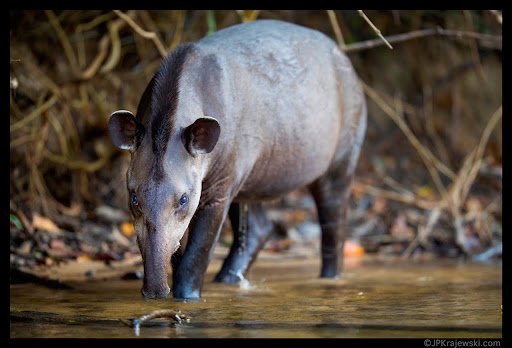
Once upon a time… large mammals flourished in the lush tropical forests of South America. Those giants evolved as key ecosystem engineers, acting as top-down regulators of ecological processes, either by predating on other smaller-sized animals, or feeding on plants, eating fruits and seeds, browsing and chewing leaves and branches, or even by trampling and changing the soil structure.
Nonetheless, parallel evolution of older, smaller and incredible creatures was continuously blooming – insects! Nowadays, those (perhaps not so) ‘tiny’ organisms are responsible for about 18% of all biomass consumed annually in tropical forests and their intricate relationships with plants, either acting as pollinators, seed predators or leaf herbivores, play a fundamental role in plant fitness and evolutionary diversification.

Photo 1 and 2. Tapirs (Tapirus terrestris) are the largest herbivore in tropical forests whose extinction indirectly affects plant-pathogen interactions. Photo: JP Krajewski.
If we look even closer, the ‘invisible’ microorganisms that perhaps regulate all other trophic-levels, the pathogens, were silently making their role in the complex food-webs of tropical forests. Pathogens here can be fungus, bacteria and/or viruses that cause damage to the leaf tissue. They are the missing links in most empirical animal-plant interaction studies, even though their importance is undoubtedly important. Therefore, how these multi-trophic interactions (ie. large animals and plant-natural enemies interactions) are structured is still a conundrum for scientists.

White-lipped peccary (Tayassu pecari) is a large mammalian herbivore but can still be found in large fragments of the Atlantic Forest. It is threatened by defaunation (‘vulnerable’ at the IUCN red list) and its absence largely impacts ecosystem functioning. Photo: PJ Krajewski
To complicate matters further, humans arrived and thrived! And with them, hunting and habitat transformation, which in modern times led to a process named defaunation. Defaunation is a worldwide recognized human-impact, in which large animals are the first to disappear due to human activities. So what we have now is a network of complex interactions, in which humans affect large-mammals, that change habitat structure while feeding on smaller animals and plants, which in turn, interact with insects and pathogens. How these interactions occur, via direct or indirect effects, and how they affect ecosystem functioning is the goal of our study in the Atlantic Forest of Brazil.

A tropical understory lead under attack by natural enemies at the Atlantic Forest, in Brazil. Photo: André Assis Bherig.
We worked in four protected areas in the State of São Paulo – famous for its megalopolis with the same name, which also, surprisingly or not, hosts some of the most preserved and biodiverse areas of the Atlantic Forest. Our four study sites have different compositions of the large herbivore communities, but nevertheless, a rich assemblage of species can be found in all of them. Due to different human pressures, sites differ in the presence of the largest ground-dwelling mammal species, the white-lipped peccary (Tayassu pecari) and the tapir (Tapirus terrestris). Although both species are present at site Itamambuca, only white-lipped peccaries are present at Ilha do Cardoso State Park; at Carlos Botelho State Park only tapirs are found, and neither of the species are present at Vargem Grande Park. However, other large herbivore species, such as collared peccaries (Pecari tajacu), brocket deer (Mazama sp.), pacas (Cuniculus paca), and agoutis (Dasyprocta spp.) are also present across sites in different numbers, including at Vargem Grande. Little or almost nothing is known about the insect and parasite communities in these areas.
In this ecological arena, we investigated how defaunation and plant’s phylogenetic diversity of large mammalian herbivores affects plant-natural enemy interactions – focusing on four guilds of insects and the guild of pathogens. We took advantage of a long-term experiment (DEFAU-BIOTA), established in 2015 and maintained by Dr Mauro Galetti’ groups, especially by Mr Sergio Nazareth and Dr Valesca Ziparro (see photograph), who knows the area very well. The experiment follows a paired design, with 86 open-closed plots located along valleys, hills and plateaus underneath a dense and rainy tropical forest. The team have followed all seedlings and saplings that rise and die over the years, marking and identifying every single plant! With the permission of Dr Ziparro who passionately takes care of those little plants, we randomly chose three subplots in each of these plots to estimate leaf damage using the classic ‘dirzômetro’ – a rapid field assessment tool to estimate the percentage of leaf consumed by different guilds of plant natural enemies. The results are rather surprising: insects were not affected by defaunation but parasites are! How this happens and the consequences for ecosystem function can be read in our main paper.
Read the paper by Emer, Carine, Nacho Villar, Valesca B. Ziparro, Sergio Nazareth, Natália Mello and Mauro Galetti. 2024. The interplay between defaunation and phylogenetic diversity affects leaf damage by natural enemies in tropical plants. Journal of Ecology 00: 00-00. DOI 10.1111/1365-2745.14273. You can read the piece here: https://besjournals.onlinelibrary.wiley.com/doi/10.1111/1365-2745.14273
Follow the Ecologists!
Carine’s website is: Carineemer.com, her Instagram: @carine.emer and LinkedIn: Carine Emer
The co-authors are on Instagram: @labic_unesp, @valescabononi, @sergiolnazareth and @nataliafpmelo. Dr Mauro Galetti’s Instagram is @dr.mauro_galetti and LinkedIn: Mauro-Galetti. Aslo Nacho Villar is on X: NachomanVillar, Facebook: nachoman.villar.1/, Instragram: nachomanecology/ & Linkedin: nacho-villar-730a42131/

Images from the ground showing the experiment setup and part of the field work. Photos: Mauro Galetti, Rafael S. C. Alves, Patrícia A. Ferreira, Carine Emer and Calebe P. Mendes.